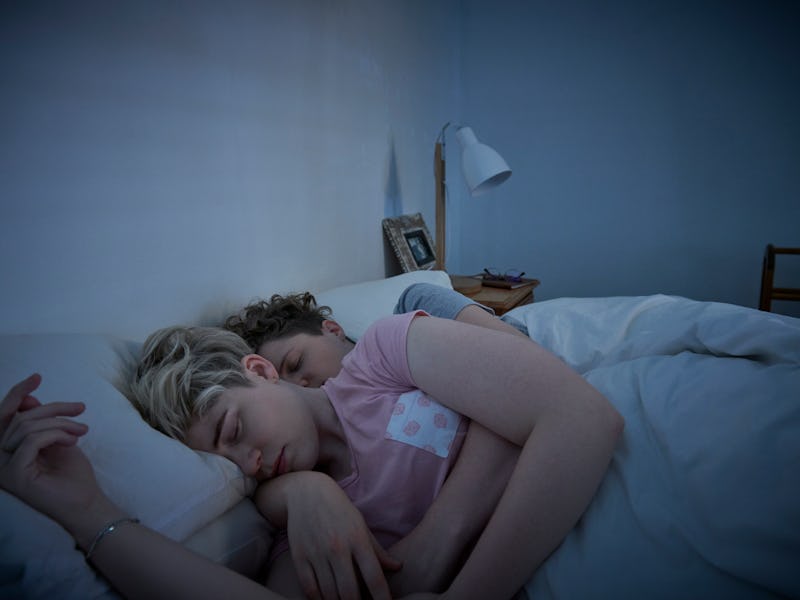Why This One Simple Habit Could Lead To Much Better Sleep
It’s time to look closer at co-sleeping — with babies and beyond.

Recent research on animal sleep behavior has revealed that sleep is influenced by the animals around them. Olive baboons, for instance, sleep less as group sizes increase, while mice can synchronize their rapid eye movement (REM) cycles.
In Western society, many people expect to sleep alone, if not with a romantic partner. However, as with other group-living animals, human co-sleeping is common despite some cultural and age-related variations. In many cultures, bedsharing with a relative is considered typical.
Apart from in Western countries, caregiver-infant co-sleeping is common, with rates as high as 60-100% in parts of South America, Asia, and Africa.
Despite its prevalence, infant co-sleeping is controversial. Some Western perspectives that value self-reliance argue that sleeping alone promotes self-soothing when the baby wakes in the night. However, evolutionary scientists argue that co-sleeping has been important in helping to keep infants warm and safe throughout human existence.
Many cultures do not expect babies to self-soothe when they wake in the night and see night wakings as a normal part of breastfeeding and development.
Concerns about Sudden Infant Death Syndrome (Sids) have often led paediatricians to discourage bed-sharing. However, when studies control for other Sids risk factors, including unsafe sleeping surfaces, Sids risk does not seem to differ statistically between co-sleeping and solitary sleeping infants.
This may be one reason why agencies such as the American Academy of Pediatrics, the National Institute for Health and Care Excellence, and the NHS either recommend that infants “sleep in the parents’ room, close to the parent’s bed, but on a separate surface,” or, if bedsharing, to make sure that the infant “sleeps on a firm, flat mattress” without pillows and duvets, rather than discouraging co-sleeping altogether.
Researchers don’t yet know whether co-sleeping causes differences in sleep or whether co-sleeping happens because of these differences. However, experiments in the 1990s suggested that co-sleeping can encourage more sustained and frequent bouts of breastfeeding. Using sensors to measure brain activity, this research also suggested that infants’ and caregivers’ sleep may be lighter during co-sleeping. However, researchers speculated that this lighter sleep may actually help protect against Sids by providing infants more opportunities to rouse from sleep and develop better control over their respiratory system.
Other advocates believe that co-sleeping benefits infants’ emotional and mental health by promoting parent-child bonding and aiding infants’ stress hormone regulation. However, current data is inconclusive, with most studies showing mixed findings or no differences between co-sleepers and solitary sleepers with respect to short and long-term mental health.
Co-sleeping in childhood
Childhood co-sleeping past infancy is also fairly common, according to worldwide surveys. A 2010 survey of over 7,000 UK families found that 6% of children were constant bedsharers up to at least four years old.
Some families adopt co-sleeping in response to their child having trouble sleeping. But child-parent bedsharing in many countries, including some western countries like Sweden where children often co-sleep with parents until school age, is viewed culturally as part of a nurturing environment.
It’s normal for children to bedshare in many parts of the world.
It is also common for siblings to share a room or even a bed. A 2021 US study found that over 36% of young children aged three to five years shared in some form overnight, whether with caregivers, siblings, pets, or some combination. Co-sleeping decreases but is still present among older children, with up to 13.8% of co-sleeping parents in Australia, the UK, and other countries reporting that their child was between five and 12 years old when they engaged in co-sleeping.
Two recent US studies using wrist-worn actigraphs (motion sensors) to track sleep indicated that kids who bedshare may have shorter sleep durations than children who sleep alone. However, this shorter sleep duration is not explained by greater disruption during sleep. Instead, bedsharing children may lose sleep by going to bed later than solitary sleepers.
The benefits and downsides of co-sleeping may also differ in children with conditions such as autism spectrum disorder, mental health disorders, and chronic illnesses. These children may experience heightened anxiety, sensory sensitivities, and physical discomfort that make falling and staying asleep difficult. For them, co-sleeping can provide reassurance.
Adults sharing beds
According to a 2018 survey from the US National Sleep Foundation, 80-89% of adults who live with their significant other share a bed with them. Adult bedsharing has shifted over time from pre-industrial communal arrangements, including whole families and other household guests, to solo sleeping in response to hygiene concerns as germ theory became accepted.
Many couples find that bed-sharing boosts their sense of closeness. Research shows that bed-sharing with your partner can lead to longer sleep times and a feeling of better sleep overall.
Bedsharing couples also often get into sync with each other’s sleep stages, which can enhance that feeling of intimacy. However, it’s not all rosy. Some studies indicate that females in heterosexual relationships may struggle more with sleep quality when bedsharing, as they can be more easily disturbed by their male partner’s movements. Also, bedsharers can have less deep sleep than when sleeping alone, even though they feel like their sleep is better together.
Many questions about co-sleeping remain unanswered. For instance, we don’t fully understand the developmental effects of co-sleeping on children or the benefits of co-sleeping for adults beyond female-male romantic partners. But, some work suggests that co-sleeping can comfort us, similar to other forms of social contact, and help to enhance physical synchrony between parents and children.
Co-sleeping doesn’t have a one-size-fits-all answer. But remember that Western norms aren’t necessarily the ones we have evolved with. So consider factors such as sleep disorders, health, and age in your decision to co-sleep rather than what everyone else is doing.
This article was originally published on The Conversation by Goffredina Spanò at Kingston University and Gina Mason at Brown University. Read the original article here.